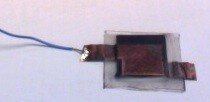Fabrication of a pressure sensor
To build a Pressure Sensor, you need:
-one piece of conductive paper
-two pieces of metal aluminum or other metallic foil or copper adhesive
-one piece of non conductive material of the size of the conductive paper (optional)
-some plastic wrappers to wrap the whole and protect it.
-wires and soldering tools
Conductive paper can be found in graphic Arts shops. Take a
multimeter with you and test the various papers that have a metallic
color and also black or gray. Indeed, you will be looking for papers
that are loaded with conductive pigments such as metallic ones,
graphite or carbon black. If the ohmmeter indicates a variation of
resistance when you place the electrodes on the paper then the paper is
conductive. The picture below show an example of conductive paper.
Conductive metals are easy to find. You can simply use aluminum
foil or you can buy some more expensive copper tape developed for
shielding applications. This can be found at:
http://products3.3m.com/catalog/us/en001/graphicarts/scotchprint/node_W46NXCHRZ7be/root_GST1T4S9TCgv/vroot_K9JT0N94GJge/gvel_RS1JV5NKF0gl/theme_us_scotchprint_3_0/command_AbcPageHandler/output_html
Here is a picture of some copper tape:
The non-conductive material can be a piece of cardboard. You will
cut it so that it makes a SPACER between the conductive paper and the
metallic foil, and enables the contact of the conductive paper and the
metal in its middle, such as the figure below. As there are two sides you can make two spacers. This is optional but it will enable to optimize the range of pressure and so the range of resistance variation. This will be infinite when no pressure is applied, whereas without a spacer you will loose some range.
Fabrication
The idea is to sandwich the conductive paper into two metal electrodes. To obtain optimal results,i.e. optimal range and repeatability of the response wherever you press on the sensor, the zone of actuation is defined by the size of the metal electrodes. If the sensor is small this will not be a problem as it will not cost a lot of metal.
If the sensor is big, say more than 20 square centimeters, this will imply to use a lot of metal. Aluminum foil is then a good alternative but you must pay attention when converting it in order not to break the conductive flow. We recommend then using a heavy duty foil with higher thickness to prevent it from breaking. However you must notice that the conductivity of aluminum is not optimal as this metal oxidizes in its surface. Also, you cannot solder on aluminum and so you will have to add some copper tape on one side of the foil to solder the wire.
Then sandwich the paper into the spacers, making sure that the paper is smaller than the spacers. Add the metal foils (electrodes) on each side and connect them to a wire. You may want to extend one side of each electrodes in order to solder the wire far from the actuation zone as shown in the figure below (here the sensor is mounted without spacer, and the metal electrodes are extended on their opposite end. One end is soldered to a wire).
Last, wrap the whole with a plastic wrapper to protect the sensor as done in the figure before. This will solidify the sensor and protect it from moisture and temperature variations as well as from your maniulation of it.
Connections:
You can then obtain a pressure sensor ready to use, you just have to
add a resistor (R1) to one of the wires for a voltage divider, the choice of the resistor
depending of course on the resistance of the paper band. The idea is to
maximise the range of a value Vout=Vin*Rpaper/(R1+Rpaper). For instance
if the resistance of the paper ranges from 100 Ohms for high pressure to 6kOhms for very light pressure, using a
resistor R1=800 ohms will provide the widest range for Vout.
For the connection to a Digital to analog Converter, the wire connected without the resistance is the ground, then the wire with the resistance is Vout and the resistance that connects to the same wire goes to Vin.
Note:
If you do not have copper foil, you cannot solder the wire. A solution is to use a stapler. This works well but make fragile connection, so take care for wrapping the connection to solidify it.








